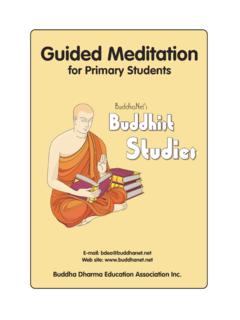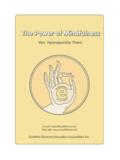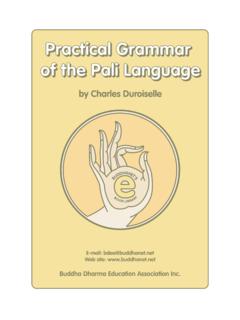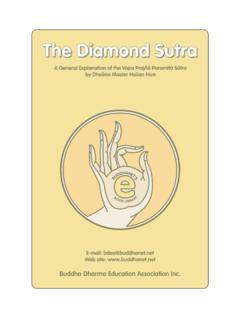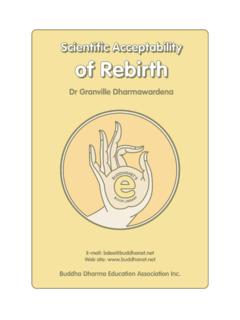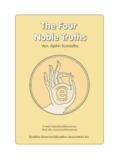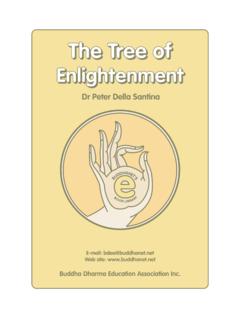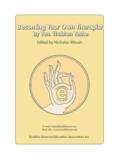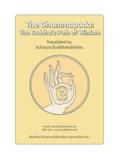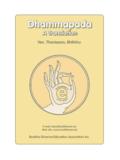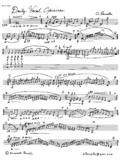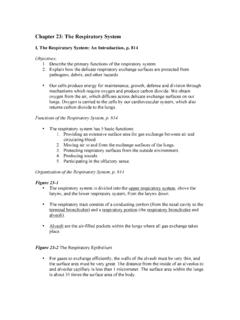Transcription of The 31 Planes of Existence - Buddhism
1 EBUDDHANET'SBOOKLIBRARYE-mail: site: Dharma Education Association Suvanno MahatheraThe 31 Planesof ExistenceThe 31 Planesof ExistenceBuddhaNet Title Page The 31 planes of existence 2 Printed in Conjunction withKathina 2001 ( 2545) ofMahindarama Buddhist (Sri Lanka) TempleNo. 2 Kampar Road 10460 Penang, MalaysiaTel: 04-282 5944 Email: 983-9439-57-XAn Inward Journey BookIJ058/01 The Thirty-One Planes of Existence (as transcribed from Bhante Suvanno s cassette recordings)byJinava saPublished byInward PathPenang Malaysia3 Printed for free distributionDedicationThis book is dedicated to all devotees ofThe Venerable c ra Suvanno Mah they enjoy the highest of blessingsAsevana ca balanam; panditanam ca sevanaPuja ca pujaniyanam.
2 Etam Mangala muttamamNot to associate with fools, to associate with the wiseAnd to honour those who are worthy of honourThis is the highest acknowledgement is extended to all thosewho have helped, each in his or her special way, tomake this Dhamma book and the audio thanks to KLA, Poay Hoon and VivianChong for their remarks, proof-reading and variouscontributions to the English language thanks to Peter Babka (Vimaladhamma)and Libor Sulak from the Czech Republic, andLee Tiam Kean for their contributions to the suc-cess of the sound system; Sisters Jacqlyn Khooand Ng Wai Foong for their vocal most of all a very special thank you to theVenerable Bhante c ra Suvanno Mah thera inallowing us to bring his Dhamma messages to dhu!
3 S dhu! S dhu!Cover design by Sunanda Lim5 ContentsDedication .. 3 Acknowledgement .. 3 Introduction .. 6 The Thirty-One Planes of Existence (Foreword) .. 18 The Thirty-One Planes of Existence .. 19K ma-loka (The Sensuous World) .. 29R pa-loka, Form Realms(The Fine Material World) .. 41Ar pa-loka, Formless Realm(The Immaterial World) .. 46 Tables (31 Realms) .. 75 Large Chart of 31 Realms of Existence .. 80 Sources .. 81 The Author .. 826 IntroductionOne of the main tenets in the Buddha s Teachingsis that all things happen due to a cause. In the con-text of birth and death, these two phenomena areactually one process. Death is followed by immedi-ate rebirth in accordance with a law known as theLaw of Causality.
4 Death signals the end of a phaseof kamma and at that point the beginning of thenext phase of kamma gives immediate rebirth inanother plane of Existence as dictated by the qual-ity of the kamma arising at that moment in time. Ican do no better than to append herewith somepertinent writings by Anagarika Sugatananda(Francis Story) on the spirit world in introducing The Thirty-One Planes of Existence by VenerableBhante Suvanno. In accordance with the universal Law of Causality,death is followed by immediate rebirth in one of thethirty-one Planes of Existence as a result of previ-ous kamma. That is to say, a being arises in theappropriate sphere to which past conscious ac-tions and habitual tendencies culminating in the death-proximate kamma , or last conscious thought-7moment, have led him.
5 If his actions of the threetypes (mental, physical and vocal , manifesting inthought, action and speech) have been directed bya purified consciousness, he will re-manifest in ahigher plane or Brahma-loka; if they have been ofmixed type he will be reborn in one of the interme-diate spheres of the k ma-loka (world of desire orsensory gratification). If his kamma has been pre-dominantly bad, with a strong reflex at themoment of death, he will be reborn in what arecalled the Duggatti (unhappy) states, including theworld of earthbound spirits or peta-loka. Thedeath-proximate kamma is an important factor indeciding the immediate rebirth.
6 It may be good orbad, but whichever it is, it tends to be the state ofmind characteristic of the individual in his previ-ous life, which takes possession of his lastmoments of consciousness before it leaves thebody. Thus a person whose predominant charac-teristic is a mental attitude of hate will at once re-manifest in a form embodying his hatred, as that ishis death-proximate kamma, induced by habitualpast thoughts. If he has cultivated Mett andKaruna (benevolence and sympathy) it is that con-sciousness that will arise in a higher plane wherethese characteristics most common type of habitual consciousnessis neither of active love nor active hatred, but desire(ta h ).
7 It is desire and attachment that bind theindividual to the wheel of Sa s ra. They providethe motives of all activities: hatred and love them-selves arise from the root cause of desire; love to-wards the object of attraction, hatred when the de-sire is thwarted. Most kamma, therefore, is of amixed type and its effects alternate in the experi-ences of the future life in the k ma-loka. The worldwherein we now find ourselves is in the k ma-loka,as it is one of the spheres dominated by desire andsensual highest doctrine (of the Buddha) teaches thebasic truth of anatta, which means that even in theearthly life-continuity of the individual there is nopersistent or unchanging entity.
8 All things are in acondition of flux; a causal continuum of successivethought-moments and material conformations aris-ing and passing away in obedience to the Law ofDependent Origination. That which is developed bymental discipline and spiritual purification is not apersonality, but a tendency. An infant carries thelatent tendencies of the past Existence and theseeds of the future life before it; but the child of five9is not the same personality as the subsequent boyof fifteen or man of fifty. Body, mind and all the ele-ments will have changed many times between thesestages of the individual s life. When we allude tothem as the same person we are only using a nec-essary convention; there is no identity linking thechild of five, the boy of fifteen and the man of is only a causal continuity; because the childexisted the man exists, and his personality is theaggregate of his thoughts, words, actions and expe-riences during the intervening period.
9 It is the func-tion of memory alone which gives this causal-continuum an appearance of being an identical per-sonality continuous in time. When age, or anyorganic alteration of the physical brain, causes thefaculties to decay, further changes of character orpersonality arises, this time caused solely throughchange in the material structure of the body. Thisis further explained in the Buddhist doctrine ofanicca (impermanence of all phenomena).We are in a better position to understand what ac-tually takes place at death and rebirth. The beingthat is reborn bears the same relationship; a causalone, to the being of the previous life as the boy offifteen does to the child of five, or the man of fifty to10the boy of fifteen.
10 It is the same person only in thesense that the one carries on the cause-effect cur-rent of the other. To use a familiar illustration: if weknew a boy of fifteen and then lost sight of him un-til he reached the age of fifty, we should findscarcely anything by which to recognise him. Un-less he bore some unusual physical characteristicof a kind to endure all his life, even his own motherwould not be able to identify section of the Buddhist scriptures, the PetaVatthu, describes the state of those reborn in theDuggatti spheres, and how they can be helped bythe living. The word Peta may be roughly translatedas ghost , though it is related to the Sanskrit Pitri,meaning ancestor.
